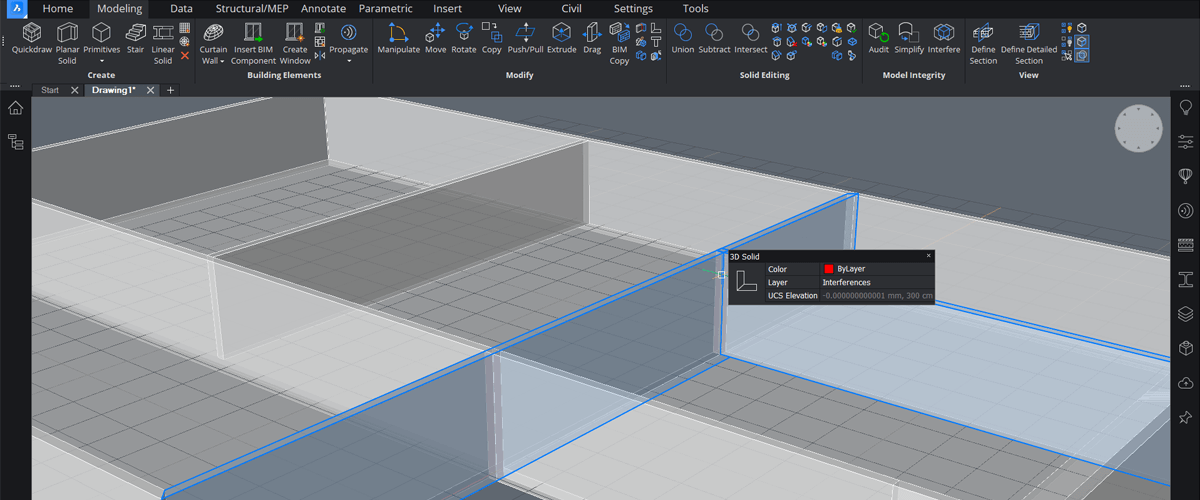Architecture, engineering and construction projects are typically long, complicated and expensive. With so many variables impacting virtually every aspect of the job, it's unsurprising that projects regularly go over schedule and budget. If AEC professionals embraced all the tools available to them, like BIM clash detection, these inefficiencies could become a thing of the past.
Historically, the AEC industry has been hesitant to adopt new technologies, primarily due to cost. In recent years, that trend has started to shift, as digital tech's benefits have proved to outweigh the upfront costs. Building Information Modeling is perhaps the most noteworthy example of this changing attitude toward technology.
In some sectors, as many as 73% of architects use BIM in most projects. These virtual modeling systems have saved companies a considerable amount of time and money, but they can still improve. Clash detection features in BIM take the technology to new heights.
What Is BIM Clash Detection?
BIM takes construction project planning into the digital age. Instead of using two-dimensional sketches or 3D physical models to plan buildings, BIM uses interactive virtual models. As a result, architects and engineers can save time and money designing projects and access a wealth of digital tools to refine their models.
BIM clash detection is one such digital tool some systems feature. It analyzes project data to highlight when a potential conflict might occur, either structural or in management. Stakeholders can then redesign or otherwise address the discord before it becomes a more pressing and expensive issue.
With a conventional approach to project design and management, these issues may not arise until the construction phase. Since BIMs are far more precise and practical than traditional ones, users can spot these issues earlier. It's always easier and more affordable to fix a problem in planning than in execution.
Clash detection enables project stakeholders to access the full benefits of BIM. As the technology improves and companies get access to more insightful data, BIM clash detection will likewise improve. Users will be able to see and react to a broader range of potential conflicts.
Types of Clash Detection
Since AEC projects are so multifaceted and involved, there's no limit to the conflicts that can emerge. Consequently, there are multiple types of BIM clash detection, each highlighting a different kind of discord. Here's a rundown of the most common clash detection methods you could use in your future projects.
Hard Clash
Of the three types of clash detection, hard clash is the most straightforward. This phenomenon occurs when two physical objects share the same space, running into each other, like a pipe colliding with a beam. While these issues are typically matters of simple geometry, they can be challenging to spot without a digital model.
Soft Clash
Soft clashes may not be as immediately recognizable, but can be equally problematic. These are instances where objects don't intersect, but their buffer zones do, creating safety problems or code violations. HVAC systems are often sources of these conflicts since they need space for maintenance workers to access them.
Workflow or 4D Clashes
The third and final type of clash detection deals with workflow or 4D clashes. Unlike the other types, these conflicts don't come from project design, but scheduling and other timeline problems. If a material delivery can't arrive on time or workers' schedules don't line up, it's a 4D clash.
Savings From Efficiency
Now you know the three areas where clash detection can help, but how do they save you money? The first and most obvious area of saving with BIM clash detection is efficiency. These tools save you time that you would otherwise spend fixing issues after they occur.
Construction projects typically take 20% longer to complete than originally scheduled. As a result, employee wages, equipment rentals and other time-related costs end up being correspondingly 20% higher. Since clash detection enables project stakeholders to prevent clashes instead of addressing them when they come up, it helps avoid these costs.

Rework accounts for as much as 34% of total project costs, according to a 2018 study. It's unrealistic to assume detection will prevent all hard and soft clashes, but it still leads to considerable savings. If it prevented just half of those requiring rework, that's a 17% cost reduction.
Rework isn't the only efficiency-related cost overrun that clash detection addresses. This automated feature saves time you may spend manually checking project models. It accelerates the planning phases, lowering wage-related costs in that area and enabling a quicker start to construction.
Savings From Safety
Clashes in construction projects impact completion times and worker safety alike. Hard and soft clashes can compromise building integrity, and time spent on rework is more time where injuries could occur. You can't assign a monetary figure to the value of human lives and health, but accidents do have fiscal consequences.
According to the National Safety Council, workplace injuries cost $41,000 per incident on average. That includes workers' compensation, insurance payouts, lost time and so on. Of course, not all clashes result in an injury, but remember that construction has a notoriously high accident rate.

Accidently can have dier consequences for construction cost, from material waste to loss of life. Robert Illes, CC BY-SA 4.0, via Wikimedia Commons
In 2019, there were more than 200,000 nonfatal injuries and illnesses in the construction industry. Almost 80,000 of those resulted in days away from work, translating to lost productivity. Given the sector's remarkably high injury rate, any safety improvement is a welcome change with fiscal benefits.
If you prevent just one accident with BIM clash detection, you can save $41,000. Your chances of avoiding an injury by preventing clashes are also reasonably high, considering how frequent construction accidents are. The less extraneous work employees have to perform, the lower the chances of a costly injury are.
Savings From Material Costs
Construction project conflicts also come with significant expenses from materials. When you have to rework a section, it typically means wasted resources and requires new materials to fix. Acquiring the new parts necessary for rework can quickly become expensive.
Materials alone typically account for 50% of total construction costs for a house and can be more for a larger structure. In addition to having to buy new supplies, you'd also lose money from the time it takes to purchase and deliver them. Considering that rework accounts for as much as 30% of construction work, these material costs will add up fast.
You may be able to avoid some extra material costs without relying on BIM clash detection. Maybe you ordered more supplies than you needed, or perhaps you could solve the issue by cutting or reshaping what you had. That's entirely possible, but assuming that every preventable mistake will work out like that is unrealistic.
Prevention is always better than a cure. If you used clash detection to avoid problems before they arise, you'd be guaranteed to eliminate extra material costs. Leaving it up to chance is too risky when these issues are so frequent and so expensive.
Other Savings
Most of these cases for savings involve hard and soft clash detection. These are typically easier to quantify, but they're not the only areas where clash detection can save money. Scheduling and management conflicts may not be as immediately obvious as other cost overruns, but they can be costly.
Disputes frequently occur in AEC, and they add 17 months to project completion times on average. According to global averages, these lengthy delays and the disruptions they cause cost $33 million apiece. That's a substantial overrun, and traditional modeling techniques can't predict these intrapersonal conflicts.
BIM clash detection can't tell if people will get along, but it can highlight situations that could contribute to conflict. Some of the most frequent causes of disputes in the industry are scheduling, contract errors and poor communication. All these factors are preventable, and clash detection can help reveal them.
4D clash detection can highlight scheduling conflicts, omissions or vagueness in contracts. When you can see these potentially contentious areas early on, you can correct them before they lead to problems. As a result, you'll ensure a smoother, more cohesive project down the line.
Altogether, the savings from BIM clash detection can amount to millions of dollars, depending on the project. If you use all three types to their full extent, it's not overly optimistic to think you could reduce project costs by 30% or more. Even if you can't avoid all clashes, you would still see a considerable reduction in expenses.
BIM Clash Detection Is a Must for Any Construction Project
The potential savings from BIM clash detection are too high to ignore. AEC is a notoriously expensive and inefficient industry, but these technologies can help change that. As these programs continue to advance, they'll become more accessible and offer greater returns on investment.
It would be unrealistic to say that clash detection can remove every disruption from the design and construction process. No single technology is that effective. However, clash detection can eliminate many, if not most, of them, potentially saving you millions of dollars per project.

